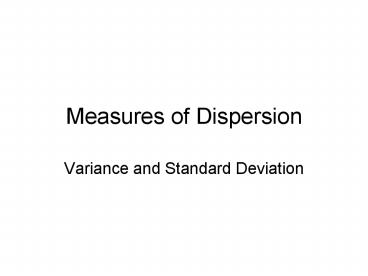Measures of Dispersion - PowerPoint PPT Presentation
Title:
Measures of Dispersion
Description:
Measures of Dispersion Variance and Standard Deviation Basic Assumptions about Distributions We should be able to plot the number of times a specific value occurs on ... – PowerPoint PPT presentation
Number of Views:178
Avg rating:3.0/5.0
Title: Measures of Dispersion
1
Measures of Dispersion
- Variance and Standard Deviation
2
Basic Assumptions about Distributions
- We should be able to plot the number of times a
specific value occurs on a graph using a line
chart or histogram (interval/ratio data) - Some distributions will be normal or bell-shaped.
- Some distributions will be bi-modal or will have
data points distributed irregularly. - Some distributions will be skewed to the right or
skewed to the left. - Theoretically, samples taken from one population,
should over time, approximate a normal
distribution. - We should have a normal distribution if we are to
use inferential statistics.
3
Other reasons to use Measures of Dispersion
- To see if variables taken from two or more
samples are similar to one another. - To see if a variable taken from a sample is
similar to the same variable taken from a
population in other words is our sample
representative of people in the population at
least on that one variable.
4
Variation in Two Samples
Sample 1 Sample 2
1 2
2 3
3 3
4 5
4 7
5 9
6 9
7 10
Mo 4 Mo, 3, 9
Mdn 4 Mdn 6
Mean 4 Mean 6
5
(No Transcript)
6
Sample 2
7
Normal Distributions are Bell-shaped and have the
same number of measures on either side of the
mean. Note According to Montcalm Royse only
unimodal distributions can be normal
distributions.
8
(No Transcript)
9
Normal Distributions
- 50 of all scores are on either side of the mean.
- The distribution is symmetrical same number of
scores fall above and below the mean. - The mean is the midpoint of the distribution.
- Mean median mode
- The entire area under the bell-shaped curve
100.
10
A standard deviation is
- The degree to which each of the scores in a
distribution vary from the mean. (x mean) - Calculated by squaring the deviation of each
score from the mean. - Based on first calculating a statistic called the
variance.
11
Formulas are
- Variance Sum of each deviation squared divided
by (n -1) where n is the number of values in the
distribution. - Standard Deviation the square root of the sum
of squares divided by (n 1).
12
Using Sample 1 as an example
1 (1-4) -3 9 Mean 4
2 (2-4) -2 4
3 (3-4) -1 1
4 (4-4) 0 0 Variance S.D.
4 (4-4) 0 0 28/(8-1) Sq Root 4
5 (5-4) 1 1 4 2
6 (6 - 4) 2 4
7 (7 4) 3 9
Total 0 28
13
Another variance/SD example
1 -5.00 25.00 Mean 6
2 -4.00 16.00
4 -2.00 4.00
8 2.00 4.00
10 4.00 16.00 Variance 90/(6-1) SD sq root of 18
11 5.00 25.00 18.00 4.24
Total 0.00 90.00
14
Other Important Terms in This Chapter
- Mean squares the average of squared deviations
from the mean in a set of numbers. (Same as
variance) - Interquartile range points in a set of numbers
that occur between 75 of the scores and 25 of
the scores that is, where the middle 50 of all
scores lie (use cumulative percentages) - Box plot gives graphic information about
minimum, maximum, and quartile scores in a
distribution.
15
Box Plot
16
Interquartile Range
Test Scores Frequency Percent Cumulative Percent
100 3 25 100
90 3 25 75
80 3 25 50
70 1 8.3 25
60 2 16.7 16.7
Total 12 100.0
17
This information is important to our discussion
of normal distributions
18
Central Limit Theorem (we will discuss this in
two weeks) specifies that
- 50 of all scores in a normal distribution are on
either side of the mean. - 68.25 of all scores are one standard deviation
from the mean. - 95.44 of all scores are two standard deviations
from the mean. - 99.74 of all scores in a normal distribution are
within 3 standard deviations of the mean.
19
Therefore, we will be able to
- Predict what scores are contained within one,
two, or three standard deviations from the mean
in a normal distribution. - Compare the distribution of scores in samples.
- Compare the distribution of scores from
populations to samples.
20
To calculate measures of central tendency and
dispersion in SPSS
- Select descriptive statistics
- Select descriptives
- Select your variables
- Select options (mean, sd, etc.)
21
SPSS output































